Content
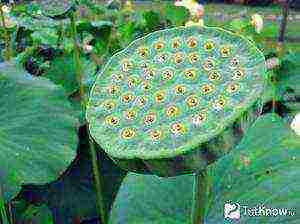 The lotus is an amazing flower. From antiquity to the present day, it carries a mystical meaning for peoples professing Buddhism. This is not surprising, the bud can reach from 10 cm to 30 cm in diameter, and the blossoming flower pleases the eye for only 4 days.
The lotus is an amazing flower. From antiquity to the present day, it carries a mystical meaning for peoples professing Buddhism. This is not surprising, the bud can reach from 10 cm to 30 cm in diameter, and the blossoming flower pleases the eye for only 4 days.
He has very delicate petals and a very strong aroma... An essential oil is produced from lotus seeds, which is as expensive as rose oil.
In nature, there are only two species of this beautiful plant: Indian and yellow. Breeders don't stop working over the breeding of new varieties of this flower... And now it has become possible for flower growers and amateurs to grow lotus at home. For this existence of this plant, the constant availability of clean water is necessary and care is very important.
How to grow a lotus?
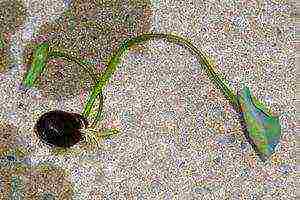 There are two ways to propagate this flower:
There are two ways to propagate this flower:
- root system;
- seeds.
Algorithm for growing a lotus by dividing the rhizome:
- Extract the tuber that has faded from the soil;
- Dry it, make sure it is healthy, there is no powdery mildew and rot on it;
- Cut the tuber into pieces so that one sprout primordium is present;
- Plant in prepared soil covered with water.
Growing this plant in this way has its pros and cons. The plus is that the plant begins to bloom faster and propagation by the root process is quite simple. The downside is that plants obtained in this way are less adaptable to other conditions. Therefore, for those who are just starting to plant lotus at home, it is better to grow it from seeds.
Growing lotus from seeds at home
It includes the preparation of planting material - seeds, a container where seedlings will need to be grown, containers for transplanting a lotus.
Selection and preparation of lotus seeds
 This point should be taken seriously enough. Carefully study the declared parameters regarding the size of the flower before buying lotus seeds, since the names of the hybrids may coincide, but length of leaves, roots and diameter of buds can be very different. Seeds remain viable for up to 100 years. However, the fresher the seeds are, the better they germinate.
This point should be taken seriously enough. Carefully study the declared parameters regarding the size of the flower before buying lotus seeds, since the names of the hybrids may coincide, but length of leaves, roots and diameter of buds can be very different. Seeds remain viable for up to 100 years. However, the fresher the seeds are, the better they germinate.
Lotus seeds are dark large oblong nuts, 1.5 cm long, up to 1 cm wide. They are very hard. Therefore, before germination, it is necessary to carry out the scarification procedure. In other words, it means breaking the waterproof shell of the seeds, otherwise the lotus seeds will simply rot.
One side of the seed is pointed and the other is blunt. From the blunt side, you need to open the outer shell so as not to damage the amniotic membrane. A file or sandpaper is suitable for this. The cutting process is a time consuming task.
The prepared planting material is placed in a plastic or glass container. It must be filled with settled water, since chlorinated water is not suitable for germinating lotus seeds. The water temperature should be from +20 to +25 degrees. The water should be changed twice a day. After about 5-7 days, the root and the first sprout will appear from the seed. A characteristic sign that the seeds have swollen and germinate will be their sinking to the bottom of the container. Those seeds that continue to float are likely to have lost their germination.
After 2-3 weeks, the sprouted shoots from the container are transplanted into a large container or directly into the reservoir. At the same time, the height of the seedlings reaches about 15 cm.
Landing algorithm
You should take an aquarium or a plastic pot without holes in the bottom, or another container with a volume of 10 to 20 liters, fill the bottom with soil. Peat can be used as soil. The sprouts should be planted in it to a depth of 6-8 cm. In this case, it is imperative that the leaves float on the surface of the water. Sprinkle the soil with a thin layer of sand, then a layer of pebbles, fill with water. The ratio of soil to water in the container should be 2: 1. The container is placed in a bright and warm place. And then it all depends on the quality of plant care.
Conditions for keeping lotus
 In vivo lotus grows in tropical climates... Therefore, the temperature regime should be at least +25 and not higher than +30 degrees. The plant is afraid of drafts. Requires a lot of light. High relative humidity is required. Often, to ensure moisture, whole compositions are created when a small fountain is placed in the reservoir where the flower grows to spray the leaves of the plant.
In vivo lotus grows in tropical climates... Therefore, the temperature regime should be at least +25 and not higher than +30 degrees. The plant is afraid of drafts. Requires a lot of light. High relative humidity is required. Often, to ensure moisture, whole compositions are created when a small fountain is placed in the reservoir where the flower grows to spray the leaves of the plant.
The thickness of the soil in the container can be at least 4 cm, and the depth of the water above it is at least 50 cm. For round containers, the sprout is planted directly in the center. If the plant is planned to be transplanted into a pond, then its depth should be at least one and a half meters.
Clean water should be added to the vessel as needed and ensured that the water does not become cloudy. Since it can be a breeding ground for the appearance of pests and the spread of diseases in the plant.
For the winter, the water from the container is partially drained, the bottom is covered with foam or moss so that the lotus does not freeze and die. And they clean it up in a dark place until spring. Until sunny and warm days come.
Lotus flowers, which are grown from seeds, appear in 2-3 years. The older the plant, the larger the buds it gives. While maintaining constant optimal conditions for temperature and illumination, it can bloom all year round.
>
 The lotus is a valuable decorative culture that occupies an important place in world culture and religion. The owners of private plots are engaged in the cultivation of this perennial amphibian shrub to decorate decorative reservoirs. The domestic lotus flower is planted with seeds or tubers and has the same care difficulties as the wild one - not adaptable to cold weather. Therefore, in the conditions of the Russian Federation, it is not easy to grow it.
The lotus is a valuable decorative culture that occupies an important place in world culture and religion. The owners of private plots are engaged in the cultivation of this perennial amphibian shrub to decorate decorative reservoirs. The domestic lotus flower is planted with seeds or tubers and has the same care difficulties as the wild one - not adaptable to cold weather. Therefore, in the conditions of the Russian Federation, it is not easy to grow it.
Description of lotus varieties
The flower has been cultivated for so long that it itself has already become part of the religion of Buddhism. In addition to its cultural and decorative value, the lotus has nutritional value. The various parts of the shrub are the basis of exotic dishes. From a botanical point of view, lotuses make up an extensive group of perennial plants of the lotus family. There are only two pure wild species:
- Indian nut-bearing, native to Asia. The growing area also covers the Amur River. Has nut-like seeds.

Nut lotus
- Yellow, North American. It has wide emergent leaves, about 70 cm in diameter. The leaves have a shiny waxy coating.
Attention! The decorative plus of the lotus is also the ability to change the position of the flower following the movement of the sun across the sky.
Also, breeders have bred several hybrids. All lotuses have a thick root, which is submerged in the underwater soil and takes out nutrients from there. The stems adapted to the aquatic environment are also completely submerged in the soil. Flexible long deciduous petioles of the plant stretch to the surface of the water.
There are three types of lotus leaves:
- underwater;
- floating;
- surface.
The flower opens for three days. During this time, some varieties even change the color of the petals. Flowers appear at different points on the leaves.
Height - up to 180 cm, in dwarf species - up to 30 cm. Other features - the shape and length of leaves and flower cups - differ depending on the hybrid. Lotus is extremely heat demanding. For flowers to appear, the plant needs 2-3 months with a stable temperature within + 23 ... + 29 ° С.In colder climates, perennials will not bloom, and in hotter and drier climates, too.
Attention! The peculiarity that became the basis of the mythologization of the lotus in ancient culture is that at night, inside the closed cup of the flower, heat is maintained at about 37 ° C. Therefore, the lotus is so fond of pollinating insects.
How to grow a lotus from seed
Growing at home from seed allows the flower to adapt in a less than suitable climate. Such plants are more resilient to drought or cold snaps. First you need to choose the right planting material. To have a chance of success, you must have tough black nuts with the following parameters:

Lotus seeds
- dimensions - approximately 1x1.5 cm;
- pericarp - strong woody.
The seed must first be scarified, filed with coarse sandpaper from a blunt end. Next, find a container - a transparent container: 90-120 cm in diameter, 25-30 cm deep. For dwarf varieties, you can take containers of a smaller volume. Do not use wavy or square containers. Young shoots of the plant can break, leaning against the corner. This will cause significant harm to the lotus.
After that, you can start landing:
- Take a small, shallow jar first. Fill it halfway with warm water (+ 18 ... + 25 ° C).
- Drop the seeds and wait. At room temperature, the first root will appear on the 5-6th day.
- 2-3 weeks after germination, the lotus seeds can be transferred to a large container. Deepen them into the peat 6-7 m. The leaves should remain above the water. To prevent the root tuber from floating up during the procedure, you can press it down with a flat stone.
- Watch out for the growth of the deciduous mass - water must be added regularly so that floating leaves remain exactly on the surface of the water. If the leaves are drowned, the lotus will die.
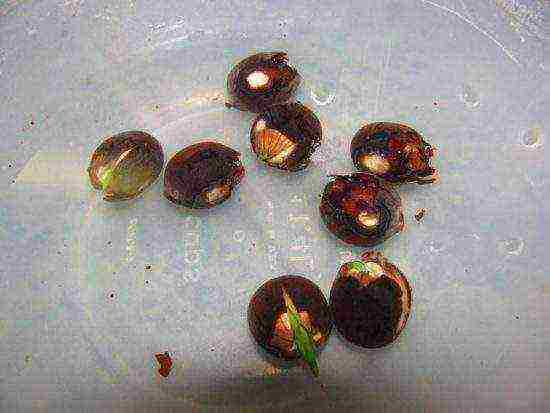
Germinating seeds in water
- The container should be in a sunny and warm place.
- Then the flower can be simply transferred to a summer reservoir or left in the format of a houseplant. The optimal time for final transfer is 5-6 leaves. Previously, a little earth or gravel should be poured over the tuber of the plant.
Features of lotus care
The main thing is to maintain optimal conditions for flower development:
- sufficient water level;
- abundance of the sun;
- temperature not lower than + 20 ° С and not higher than + 29 ° С.
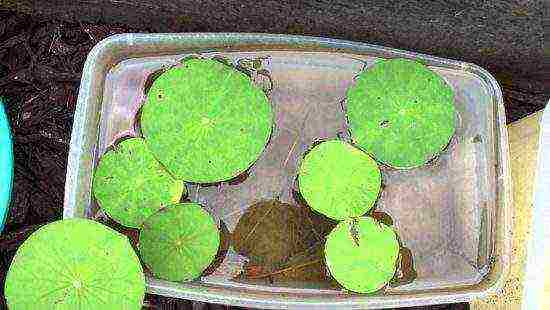
Growing a lotus in a container
Domestic gardeners have gotten used to placing the lotus in ponds directly in containers in order to hide the flower behind home walls with a cold snap and take it out again after the end of the frost. You can also leave the lotus in the pond by simply covering it with foam in the fall. For storage indoors, part of the water must be poured out of the pot, and the plant itself must be insulated with moss.
The pot should be in a cool place. Watering and disturbing the lotus in every way is impossible. Make sure that the temperature in the storage area does not rise in the spring and the plant does not come to life ahead of time. In open reservoirs or large pots for an adult plant, it is enough to observe simple conditions so that the plant does not wither:
- ground level - from 3.5 cm;
- the thickness of the water layer is at least half a meter;
- placing the rhizome in the center of the container.
The lotus is a target for habitual garden dwellers - caterpillars or aphids. Insects can simply be washed off with water. It is important to do this in the morning. You can also use special drugs.
Be prepared that even with perfect care, flowers will not appear for a long time, and green "pancakes" will simply float above the surface. Lotus owners wait 2-3 years for the first flower. After wilting and dying off of the inflorescence, a seed capsule forms in its place.
Growing a lotus from seeds: video
Lotus, a very exotic flower. It is one of the few plants that live in water. Many myths and legends are associated with the lotus, and it is not an easy task to grow it.This flower is of great interest to breeders, they are constantly working to improve the properties of existing varieties and develop new ones. Miniature varieties have already been bred that can be grown at home even in a small bowl. There are two types of lotuses. The first is Indian, the second name is nut-bearing. The homeland of growth is Asia. The second type is the yellow lotus. First found in North America and Hawaii. In Buddhism, this plant is considered sacred and personifies spirituality and purity.

Lotus flowers are very delicate and can be very large up to 30 cm in diameter in some varieties. The petals are mostly in pastel colors - lemon, yellow, white, pale pink. The flowering period of lotus flowers is very short - only 4 days. After that, the petals fall off, and a box with seeds remains. Seed germination lasts a very long time - up to 100 years.
The lotus leaves are of two types - underwater and those that float on the surface. The latter are large in size, about 70 cm, and are located on long petioles. To grow this miracle at home, you need to follow certain rules for keeping the plant and take into account the peculiarities of its vegetation.

Growing lotus
There are two ways to breed a lotus - by seeds and by dividing the rhizome.
Growing from seeds
This method is more preferable for those regions where the climate is not tropical. Plants grown in this way adapt better to local temperature conditions and tolerate droughts more persistently in summer. Externally, lotus seeds resemble nuts covered with a hard pericarp. For a faster emergence of seedlings, the seeds are slightly filed from the blunt end. To do this, use sandpaper, as it is easier and more convenient. Then the seeds are placed in a small container with clean water.
The appearance of the first root can be observed after 5 days. The water in the container should always be lukewarm. Its optimum temperature is from +18 to +25 degrees. After a couple of weeks, the sprouts can be transplanted to a permanent place. Lotuses can be kept either in open water or in a pot at home. If grown at home, then the pot is filled with peat or earth and poured over with water. Sprouted seeds are buried 7–8 cm into the soil, while the underwater leaves should also be in the ground, and the emergent leaves remain floating on the surface. Water is topped up periodically.
Growing from rhizome
This method also has its advantages. Plants grown in this way begin to bloom earlier. One process must be separated from an adult plant. It looks like a banana in appearance. Then it is laid in the ground or peat, flooded with water. These processes take root and grow quickly.
During seed germination by any of the proposed methods, it is necessary to change the water at least once every three days. If the water stagnates, the sprouts will start to rot and die. Water must be defended for at least three days before changing.
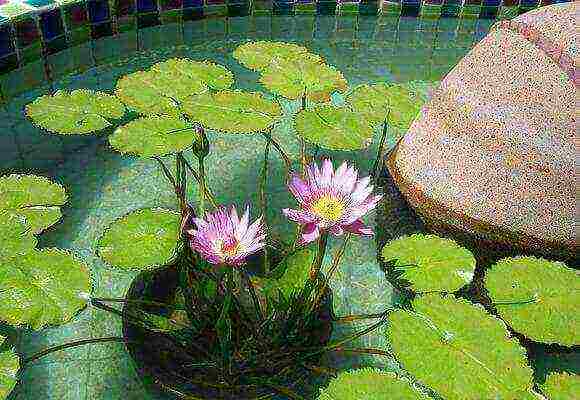
Lotus keeping rules
Temperature regime
In its natural environment, this plant lives in the tropics. Therefore, he has special temperature requirements. All year round, the temperature where the lotus is grown should be +25 - 30 degrees.
Lighting
Lotuses are very light-requiring, so you need to find the most illuminated place. If the necessary temperature conditions and lighting are observed constantly, then the plant can bloom all year round.
Air humidity
The flower has a positive attitude to high humidity. Leaves and petals do not suffer when water drops on them, therefore lotuses are often placed in reservoirs with fountains. Fountains create additional moisture in the air and look very beautiful in a composition with flowers.
Pests
Sometimes plants are damaged by aphids and caterpillars. Aphids can be fought by simply washing them off with water. Or purchase insecticides designed to combat these pests.
Substrate composition
It is better to choose large pots as a container for growing at home. Soil is poured into them, and the thickness of the layer should be at least 4 cm, and the thickness of the water layer is about 50 cm. If the pot is round, then the root is planted exactly in the center. Water periodically needs to be topped up to the required level.
Winter care
If the plant is in a pond or other open water body, then with the onset of cold weather it is covered with a foam plate. This will help insulate the lotus. When growing a lotus at home in a pot, some of the water is drained. The pot is insulated with moss and placed in a dark, cool place. You don't need to add water until spring.

Lotuses are great for growing in summer cottages, so if there is a small pond, the depth of which is at least 1.5 meters, then you can safely plant these beautiful flowers. And if there is no summer cottage and an open reservoir, then by purchasing seeds of miniature varieties, you can keep this plant in an apartment in a small pot.
Subject to the simple rules for growing and maintaining a lotus, it will delight the owners not only with the sight of its beautiful flowers, but also with a wonderful aroma. The petals contain aromatic oils, which are very much appreciated by perfumers. They are used in the manufacture of perfumes, aromatic oils and other perfumery products.

Lotus is a flower of an amphibian perennial shrub. You can see large white or pink flowers in nature only in southern countries. Healthy seeds of this plant are also collected there. Florists have found ways to grow lotus at home, but not everyone can grow and get seeds. The reason for this is the European climate with its very cold winters. Therefore, the difficulty in growing a lotus at home is precisely in getting used to frost. If this happened, then it can be argued that the cultivation of the plant will be flawless.
Lotus breeding methods
At home, two methods are used:
- rhizomes (by dividing them);
- seeds.
Root way
This homemade method is good because it portends accelerated flowering. The roots of the lotus are fleshy, juicy. They resemble bananas in shape. One of the shoots breaks off and fits into the soil covered with water. The sprout appears quickly, takes root, and for a year or two you are provided with beautiful flowers.
Growing lotus at home with seeds
This method of home growing is good because it allows the plant to better adapt to the European area. Sprouted from seeds, the lotus will better endure both summer droughts and coolness.
Ready-to-propagate lotus seeds look like black nuts. They are just as hard and have a very strong woody pericarp. Their size: height approximately 1.5 cm, diameter - 1 cm. In order for a lotus seed to sprout, it is scarified. This means from the blunt end (where the hole is) it is filed. You can use coarse sandpaper, it's faster and easier. It takes about 5 days for the first root to appear.
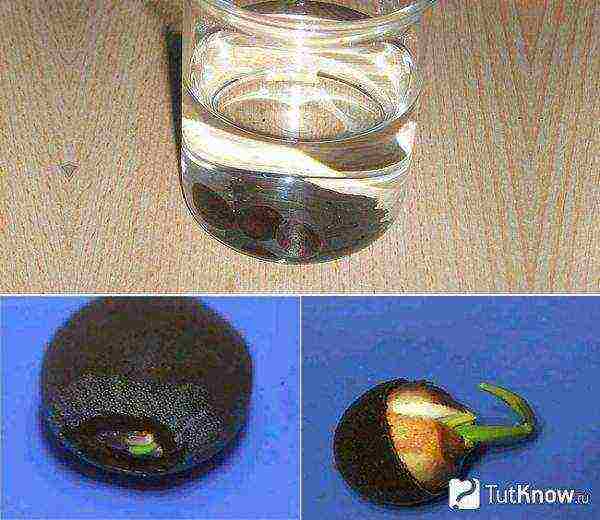
A shallow glass dish is taken, or a plastic cup at worst, a little warm water is poured (approximately + 18―25 degrees) and the seeds are lowered there. We are waiting for the first sprout to "hatch".


After two to three weeks, we are preparing a new container for transplanting the germinated lotus. It can be a pot (for indoor breeding) or a summer reservoir in the country. The container is filled with earth or peat and poured over with water. Lotus seeds that have taken root and leaves go deep 7-8 cm into the ground, and the leaves should be on the surface. As it grows, water is added: it is necessary to ensure that the leaves always float on the surface. If the sprouts with leaves are drowned, then the young plant will die.

Flowers do not appear as soon as we would like. Up to this point, the deciduous part of the lotus bush simply floats on the surface. The first beautiful flower can be expected no earlier than in 2.5-3 years.After the color has come off, a seed box will appear.
Sprout care

Proper home care for lotus sprouts is very simple: the main thing is not to forget to add enough water, give a lot of sunlight and heat. You can take the flower out into the open air after the completion of all frosts. Low temperatures will destroy the lotus.
Choice of capacity
Lotus grows well in large pots or open reservoirs (pits). The soil should be no thinner than 3.5 cm for an adult plant, and the water should be approximately 0.5 meters. If a large and round pot is chosen for planting, then the lotus root is placed strictly in the center.
Lotus in winter
In winter, the plant is not watered or disturbed. If the lotus is left in an open reservoir, then for insulation it is covered with ordinary foam from late autumn. At home, part of the water is drained from the pot, insulated with moss, placed in a dark, cool place and not watered. In the spring, it is important to make sure that the bush does not grow prematurely.
Lotus disease
Like most plants on the lotus, there are pests - aphids, caterpillars. Aphids can be washed off with water, it is better to do this in the morning. In specialized stores, means for treating leaves from diseases and pests are sold.
Video about thermophilic lotus flowers that can be grown in Russia:
Photos of lotus flowers:














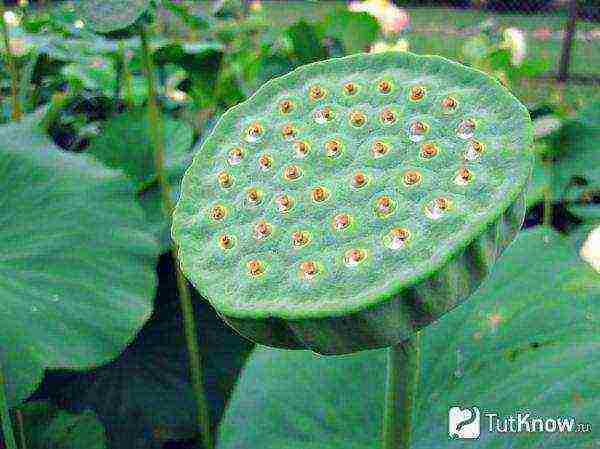






Source


